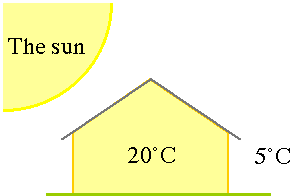
Solar en(x)ergy versus heating (cooling) needs

Solar power inflow to the earth:
Sunlight during one year:
Assume a one storey house of 100 m2, then the available yearly sunlight for the house becomes about:
The heating need during one year in Sweden (without good insulation) for the house is about:
*The exergy factor E/Q = 0.05 is calculated from the so called Carnot relation: E/Q = (T - T0)/T, where the temperature is measured in Kelvin, i.e. temperature in degrees Celsius + 273.15. Here T = 20 + 273.15 = 293.15 K and T0 = 5 + 273.15 = 278.15 K, which gives E/Q = (293.15-278.15)/293.15 = 0.05
NB: The problem of cooling a house in a warm climate is analogous.
Relation between available and needed energy and exergy becomes:
If you wonder why this is not done, you might ask yourself: Who would gain from this?
The Japanese industrial leader Konosuke Matsushita have said:
"We are going to win and the industrial West is going to lose out; there's not much you can do about it because the reasons for your failure are within yourselves. Your firms are build on the Taylor model. Even worse, so are your heads. With your bosses doing the thinking while the workers wield the screwdrivers, you're convinced deep down that this is the right way to run the business. For you the essence of good management is getting the ideas out of the heads of the bosses and into the hands of labour. We are beyond the Taylor model. Business, we know, is now so complex and difficult, the survival of firms so hazardous, in an environment increasingly unpredictable, competitive and fraught with danger that their continued existence depends on the day-to-day mobilisation of every ounce of intelligence."
The Chinese refused to accept the smuggling of opium by Europeans to China, then the Europeans declared China war, the Opium wars.
The Opium wars
The Opium Wars (1839-42, 1856-60), the first major military clashes between China and the West, ended the long Chinese isolation from other civilizations. For China, defeated in both conflicts, these wars represented the beginning of a century of humiliation by foreign powers through the imposition of unequal treaties that extracted commercial privileges, territory, and other benefits from the Chinese government.
The First Opium War stemmed from China's efforts to bar the illegal importation of opium by British merchants. Britain scored an easy military victory. By the treaties of Nanjing (Nanking, 1842) and the Bogue (1843), China opened the ports of Guangzhou (Canton), Amoy, Fuzhou (Foochow), Ningbo (Ning-po), and Shanghai to British trade and residence, ceded Hong Kong to Britain, and granted British extraterritoriality, that is, the right to try British citizens in China in British courts. Other Western powers soon received similar privileges.
The Second Opium War, or Anglo-French War, in China also resulted from China's objections to the opium trade. A joint offensive by Britain and France secured another victory. The Treaty of Tianjin (Tientsin) was signed in 1858, but the Chinese refused to ratify it. Hostilities resumed, and Beijing (Peking) was captured by the Western allies. In 1860, China agreed to the provisions of the treaty, which opened 11 more ports, allowed foreign envoys to reside in Beijing, admitted missionaries to China, permitted foreigners to travel in the interior, and legalized the smuggle of opium.
A traditional Chinese opinion about Europeans is as follows (Wood, M., Legacy):
"These barbarians have a grim lock, untightly hair and unpleasant smell. They have no rituals worthy of the name. They are liars and rather arrogant. They concur countries by fraud and false ingratiating themselves in a friendly way before they oppress the natives. At the heart of their conduct is violence."
Bibliography: Beeching, J., The Chinese Opium Wars (1975); Fay, P. W., The Opium War, 1840-42 (1975); Smith, D. B., and Lumby, E. W., eds., The Second China War, 1856 to 1860 (1954; repr. 1985); Waley, A., The Opium War through Chinese Eyes (1958; repr. 1968).